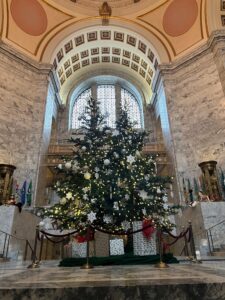
Holiday tree displayed in the Capitol building.
(Photo Credit: Erica Hallock)
Trivia!
The newest reconstructed building on the Capitol Campus is named after former State Senator Irving R. Newhouse. What was the building’s original name and what is former Sen. Newhouse’s political legacy in Washington State?
Tana Senn Announced as New DCYF Secretary
Governor-elect Ferguson has selected a familiar face to lead Washington’s Department of Children, Youth and Families with today’s announcement of State Representative Tana Senn as the incoming Secretary. Representative Senn is the current Chair of the Human Services, Youth, and Early Learning Committee and was the key architect of the Fair Start for Kids Act. I’m sure I speak for all of us when I wish her the very best at leading a complex state agency that oversees not only early learning but also Child Welfare and Juvenile Rehabilitation – we are very excited to work with her in this new role!
Release of Governor Inslee’s Proposed Budgets
On December 17th, Governor Jay Inslee released his final proposed biennial budgets. In what may be his final press conference as Washington’s Governor, Governor Inslee laid out the strategy behind his final budgets given the state’s fiscal challenges. (As a reminder, our state has a total of three budgets – Operating, Capital and Transportation). These comments were made after he bestowed a special honor to his wife, Trudi, by gifting her with his official Washington pin honoring her as the inspirational Washingtonian for the day. Governor Inslee said he had been waiting to do this for 12 years.
- Proposed New Revenue. Governor Inslee started his remarks by reflecting that when he assumed office in 2013 the state was still recovering from a recession that resulted in deep and painful cuts, particularly to human services programs. The Governor contrasted the situation today that while our state’s costs are up, we are not in a recession and our economy is booming. He then laid out his plan to adopt a wealth tax that would place a 1% tax on Washingtonians with assets over $100 million. According to the Governor, this would impact approximately 3,400 individuals and would generate $10.3B in revenue over four years (2025-2029).The Governor’s budget also includes an assumed $2.6B in revenue from increased Business and Occupations Tax Revenues, among other proposals. In all, the Governor’s released budget assumes $12.9B in new revenue over the four-year (2025-2029).
- “Book One and Book Two Budgets.” Our state’s governor is required to propose a balanced budget. Typically, during tough financial times, a “Book One” budget achieves that balance with an “all-cuts” approach and a “Book Two” budget typically contains proposed revenue to “buy back” some of the cuts. The budget released publicly this week is the “Book Two” budget in that it contains revenue – and a significant amount at that. Governor Inslee’s “Book One” budget was not released publicly, so it is not clear what his proposed “all-cuts” budget would look like.
- What about our incoming Governor? Great question! Come January 15, 2025, we will have a new Governor when Bob Ferguson is sworn in, and he will have an opportunity to put his mark on the budget. We do not expect him to submit a line-by-line “replacement” budget. Instead, the expectation is that he will submit to the Legislature his own priorities, which he has signaled to be around increased funding for local law enforcement and housing. More to come…
Proposed Early Learning Investments
- Working Connections Child Care.
- Fund Working Connections Child Care Subsidy at the 85th Percentile of the 2024 Market Rate Survey ($272.81M for child care centers and $183.54M to fund the Family Child Care Collective Bargaining Agreement for the 2025-27 biennium – for a total of $456.35M).
- Delay Expansion of Working Connections Child Care Eligibility to the 75% of State Median Income until State Fiscal Year 2031 (Savings of $119.5M for the 2025-27 biennium).
- Working Connections Child Care Outreach ($4.8M for the 2025-27 biennium).
- Child Care and Development Fund Compliance ($67.49M State General Fund + $20.53M Federal for the 2025-27 biennium – for a total of $88.02M). Funding would support enrollment-based payments, prospective payments, 12 months of full eligibility, adding additional children during the eligibility period and restricting overpayments in certain circumstances.
- Consolidation of Seasonal Child Care (Savings of $3.12M over the 2025-27 biennium). Program deemed longer needed because it has been absorbed into Working Connections Child Care.
- Early Childhood Education and Assistance Program (ECEAP)
- Delay Implementation of Entitlement Until the 2030-31 school year (Savings of $145.89M over the 2025-27 biennium).
- Rate Increase of 18% for School-Day Programs Starting in State Fiscal Year 2026 ($55.68M for the 2025-27 biennium).
- Slot Conversion/Expansion – Convert 250 Part-Day Slots to School-Day and add 500 School-Day Slots ($9.39M over the 2025-27 biennium).
- ECEAP Underspend – Sweep funding for 845 currently unfilled part-day slots (Savings of $17.04M for the 2025-27 biennium).
- Early Learning Facilities
- $50M for competitive grants through the Early Learning Facilities (ELF) Fund – including $45M for eligible organization grants and $5M for health and safety minor renovations.
- $8.629M for 9 school district projects recommended by the Department of Commerce.
- Additionally, the Department of Commerce’s Local Community Projects budget includes $5M for Willard Early Learning Center (Tacoma) and the Department of Commerce’s Building Communities budget includes $1.57M for Jefferson County Early Learning & Family Support Center (Sequim).
- Additional Early Learning Investments
- Home Visiting
- The proposed 2025 Supplemental Budget (the current fiscal year we are in) presumes $400,000 in savings from the Home Visiting Services Account underspend.
- Transition to Kindergarten
- Funding to OSPI to distribute grants – in collaboration with DCYF – to support school districts in blending ECEAP and Transition to Kindergarten classrooms ($2M for the 2025-27 biennium).
- Professional Development
- Funding for DCYF to continue contracting with an organization that provides “relationship-based professional development support” to child care providers in various settings to establish and support new child care programs. Funding to support the opening of approximately nine new child care businesses per year. ($500,000 for the 2025-2027 biennium)
- Continue Pierce County Pilot
- Continued funding to support efforts in Pierce County to implement a countywide resource and referral linkage system and a voluntary newborn support program ($2.5M for the 2025-27 biennium).
- Home Visiting
Washington State Standard State Budget Resource
On December 9th, the Washington State Standard featured an excellent overview detailing the state’s budget situation. The article described the contributing factors of stagnant revenues and increasing costs, including expenses slated to come on-line in the next biennium such as the next steps of the Fair Start for Kids Act. It also included potential options on the table for raising new revenue. Worth a read!
2024 Legislative Committee Days
Olympia was a flurry of activity during the week of December 9th for the annual rite of passage known as “Committee Days.” During Committee Days, current, future and soon to be former Senate and House members gather at the Capitol campus for a busy week of work sessions, meetings and fundraisers sprinkled in.
It is an intense week followed by an immediate reprieve – kind of like if the first day of school was immediately followed by winter break! Newly elected legislators received a taste of what awaits them in January – lobbyists chasing them down, their days blocked out in 15-minute increments, and jumping constantly from one topic to another. It is fair to say every Committee Days participant left exhausted and maybe a tad nervous about their session stamina!
Legislative Changes. As we wrote in our November Notes From Olympia, changes in the legislative make-up did not stop after the election. Last week, the King County Council appointed Tina Orwall to fill the seat of retiring Senator Karen Keiser of the 33rd Legislative District and also appointed Edwin Obras to fill Orwall’s House seat.
Over in the 26th Legislative District, Deborah Krishnadasan was appointed to fill the Senate seat of departing Senator Emily Randall who was elected to the U.S. House of Representatives.
Senator Patty Kuderer of the 48th Legislative District is expected to resign her Senate seat early in the new year to assume the elected position of Office of the Insurance Commissioner. Reportedly, her two seatmates, Representatives Vandana Slatter and Amy Walen, are both interested in that Senate seat. Should one of them receive the appointment, their House seat would also need to be filled by appointment.
Making matters even more interesting, the rumor mill is also going strong that some sitting legislators could be heading to the Ferguson administration to lead state agencies. If that occurs, of course their legislative seats would need to be filled by appointment.
If you are one of those people that select an inspirational word for a new year, perhaps you might want to select “change” or “patience.”
Committee Work Sessions. The work sessions during Committee Days often provide insight into 2025 priorities. Given the state’s precarious budget situation, it was not a surprise that both the Senate Ways and Means and House Appropriations Committees dedicated time to briefing their committee members on the budget situation.
- House Appropriations Committee. On Monday, December 9th, the House Appropriations Committee held a full work session. Related to child care, the Department of Children, Youth and Families’ Allison Krutsinger and Nicole Rose presented to the Committee on “Child Care Access and Affordability” (their presentation begins at 48:50). Their accompanying PowerPoint includes helpful data about subsidy utilization and provider capacity.
- Additionally, the Committee’s Budget Coordinator Mary Munroe presented a helpful budget overview that provides an excellent primer on the state budget process. This is one I am keeping as a resource!
- Senate Ways and Means Committee. Over in the Senate Ways and Means Committee, on December 12th, the Committee heard the latest updates about our state’s caseloads and revenue forecasts (these two presentations started out the work session). This information was included in our November Notes from Olympia, but for reference, the caseload forecast information is here and the revenue forecast information is here.
Prefiled Bills
At the start of December, legislators can “prefile” bills with the Code Reviser’s Office. The Code Reviser’s Office is a critical support to the legislative process. For an inside look at how the Code Reviser’s Office helps with bill drafting, check out TVW’s behind the scenes explainer. (On a side note about the Capitol campus construction, with the Pritchard library construction underway, the amazing staff of the Code Reviser have been moved to the modular building on the northwest part of campus, the former temporary home of the Senate Republicans).
Prefiling opened on December 2nd for the 2025 session. Prefiled bills will be introduced the first day of session, Jan. 13th, and will then be assigned to a committee to proceed through the legislative process.
Related to early learning, three bills have been introduced to date. We’ll cover them briefly in this edition and dive deeper into their detail at the start of session:
- HB 1033. Sponsored by Rep. Couture, HB 1033 would allow counties to opt to act as the regulatory and licensing authority for child care centers and family home providers. The bill would also require DCYF to complete a study on the rate of utilization of this new local licensing and regulation option, and analysis of perceptions from providers, local governments, and DCYF of the local and state licensing and regulatory options. Effective 7/1/26.
- HB 1082. Sponsored by Reps. Senn and Eslick, this bill would allow licensed child care providers until August 1, 2028 to demonstrate experience-based competency as an alternative to comply with current child care licensing rules. It would also direct DCYF to convene a stakeholder group to improve early learning and school-age staff qualification requirements and verification processes.
- SB 5062. Sponsored by Senator Stanford, this bill would create the Washington State Child Care Workforce Standards Board with specific designated members and would requires the Board to adopt statewide rules every four years establishing minimum child care employment standards relating to compensation, health and safety, and other working conditions. The bill would exclude the licensing of child care facilities from the Board’s purview.




